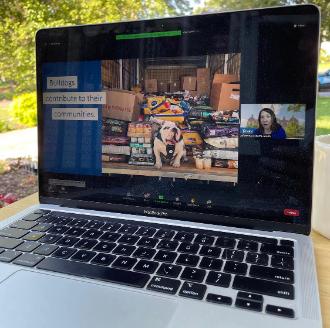Virtual Meetings and Programs
Drake University provides all students, faculty, and staff free access to the video conferencing software, Microsoft Teams, through MyDrake. This is a great tool for virtual meetings and programs.
Also, if you are a President of an RSO and do not have access to your RSO Google Doc, please email student.life@drake.edu

Utilizing Microsoft Teams
- You can access Teams from MyDrake.
- Click on the waffle/grid menu in the upper left corner.
- Select the Teams icon.
- NOTE: You can also search for Microsoft Teams in the All Apps section of the waffle menu.
For more instructions on how to use Microsoft Teams to have meetings and make calls, click here.
Tips for Running Virtual Meetings
-
Test out your technology before the start of the meeting. Work with a friend to test out your meeting platform to make sure everything works.
-
Opt for video calling. While not everyone loves the idea of video calls, they increase connection and community. When possible, choose video calling for a more personal approach to staying connected. Note that in cases where reception is bad, you may have to switch off video calling.
-
Start each meeting with an icebreaker where everyone gets to share. If there are a lot of participants, consider using the chat features for people to respond and share.
-
Stick to set times. Set standard weekly times meetings should take place for consistency. We recommend keeping with the regular times you had prior to going remote.
-
Set clear agendas, outcomes, and action items. We recommend using Google Docs as a way of creating living agendas where people can see updates in real time and items as the meeting goes along. At the end of every meeting, be sure to articulate clear action items and next steps.
-
Create new roles and rotate responsibilities. Think about daily and weekly tasks such as taking meeting minutes and rotate these amongst members to stay engaged. Additionally, consider forming new and creative subcommittees that can work on projects in more intimate chat groups.
-
Get buy-in. Make sure to create space for allowing others to provide thoughts and input. It’s important to ask things like “what do people think of this?” or “does anyone have anything to add?” Be ok with some silence on the other end as some people may need additional time to think.
-
Meet one-on-one. If you are in a leadership role within your organization, consider scheduling one on one check-ins with other Executive Council leaders and members. This is a great way to maintain connection and be able to accommodate the different needs of your group.
Tips for Organizing
-
Centralize organization documents. Consider using your RSO Google Doc for project management for being able to share information with your organization in a timely, adjustable fashion. If you cannot find access to you RSO Google Doc, email student.life@drake.edu
-
Consider a communication channel and set expectations. Consider using Google chat, What’s App, or even Facebook messenger as a centralized channel for the organization to communicate. This can help keep everyone up-to-date and help avoid the confusing text message chain.
Tips for Engaging Members
While ensuring you continue to meet the mission and purpose of your organization is important, it’s also important to recognize that much of what your organization does is social, connecting students to one another. Even in a virtual environment, there are lots of ways to help people connect informally and socially. Here are some ideas:
- Host a daily check-in or kick-off for members. This may be focused on organization-related items, or an opportunity to just wish everyone a great day!
- Host virtual office hours outside of meetings for more personal connections and conversations.
- Create a regular newsletter. There are a number of great resources such as Constant Contact and MailChimp that allow you to create free electronic newsletters. This can be a great way to keep members up-to-date with the activities of the organization.
- Consider adding trivia questions or fun challenges to make the newsletter more interactive.
- Create a “virtual watercooler”. Your members may want time to just spend time hanging out together onlline.
Tips for Engaging Your Executive Council
Discuss with your Executive Council your organization's purpose and mission, then answer these questions:
-
What absolutely must and should continue virtually?
-
What should be postponed?
-
What can we let go of that doesn't need to be done?
Get really clear on what is and isn't a priority for your organization and the students it serves, giving your leadership and your members permission to really hone in on the most important aspects of your mission and purpose. Do them well, and let the rest go. Remind your members that doing less and doing it better is an excellent way to model leadership.
*Note* many Tips and Tricks pulled from UC Boulder

